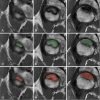Prediction of femoral head collapse in osteonecrosis using deep learning segmentation and radiomics texture analysis of MRI
- PMID: 39482688
- PMCID: PMC11526660
- DOI: 10.1186/s12911-024-02722-w
Prediction of femoral head collapse in osteonecrosis using deep learning segmentation and radiomics texture analysis of MRI
Abstract
Background: Femoral head collapse is a critical pathological change and is regarded as turning point in disease progression in osteonecrosis of the femoral head (ONFH). In this study, we aim to build an automatic femoral head collapse prediction pipeline for ONFH based on magnetic resonance imaging (MRI) radiomics.
Methods: In the segmentation model development dataset, T1-weighted MRI of 222 hips from two hospitals were retrospectively collected and randomly split into training (n = 190) and test (n = 32) sets. In the prognosis prediction model development dataset, 206 hips were also retrospectively collected from two hospitals and divided into training set (n = 155) and external test set (n = 51) according to data source. A deep learning model for automatic lesion segmentation was trained with nnU-Net, from which three-dimensional regions of interest were segmented and a total of 107 radiomics features were extracted. After intra-class correlation coefficients screening, feature correlation coefficient screening and Least Absolute Shrinkage and Selection Operator regression feature selection, a machine learning model for ONFH prognosis prediction was trained with Logistic Regression (LR) and Light Gradient Boosting Machine (LightGBM) algorithm.
Results: The segmentation model achieved an average dice similarity coefficient of 0.848 and an average 95% Hausdorff distance of 3.794 in the test set, compared to the manual segmentation results. After feature selection, nine radiomics features were included in the prognosis prediction model. External test showed that the LightGBM model exhibited acceptable predictive performance. The area under the curve (AUC) of the prediction model was 0.851 (95% CI: 0.7268-0.9752), with an accuracy of 0.765, sensitivity of 0.833, and specificity of 0.727. Decision curve analysis showed that the LightGBM model exhibited favorable clinical utility.
Conclusion: This study presents an automated pipeline for predicting femoral head collapse in ONFH with acceptable performance. Further research is necessary to determine the clinical applicability of this radiomics-based approach and to assess its potential to assist in treatment decision-making for ONFH.
Keywords: Deep learning; MRI; Machine learning; Osteonecrosis of the femoral head; Radiomics.
© 2024. The Author(s).
Conflict of interest statement
The authors declare no competing interests.
Figures







References
-
- Hindoyan KN, Lieberman JR, Matcuk GR, White EA. A Precise and Reliable Method of determining lesion size in osteonecrosis of the femoral Head using volumes. J Arthroplast. 2020;35(1):285–90. - PubMed
-
- Lafforgue P, Dahan E, Chagnaud C, Schiano A, Kasbarian M, Acquaviva PC. Early-stage avascular necrosis of the femoral head: MR imaging for prognosis in 31 cases with at least 2 years of follow-up. Radiology. 1993;187(1):199–204. - PubMed
-
- Sultan AA, Mohamed N, Samuel LT, Chughtai M, Sodhi N, Krebs VE, Stearns KL, Molloy RM, Mont MA. Classification systems of hip osteonecrosis: an updated review. INT ORTHOP. 2019;43(5):1089–95. - PubMed
MeSH terms
Grants and funding
LinkOut - more resources
Full Text Sources
Medical

